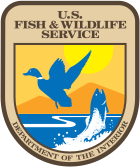United States Fish and Wildlife Service
|
|||
|---|---|---|---|
| State level | Federation | ||
| Position of the authority | Federal government agency | ||
| Supervisory authority (s) | United States Department of the Interior ( United States Department of the Interior ) | ||
| Consist | June 30, 1940 | ||
| Headquarters | Arlington County , Virginia | ||
| household | $ 2.445 billion (2012) | ||
| Authority management | Aurelia Skipwith | ||
| Employee | 9542 (2012) | ||
| Website | www.fws.gov | ||
The United States Fish and Wildlife Service ( USFWS or FWS for short ) is an agency subordinated to the US Department of the Interior whose task is the conservation of nature and its biodiversity in the United States . It had a budget of $ 2.445 billion in 2012 and 9,542 employees.
Structure and tasks
The authority includes the following units, among others:
- Bird Habitat Conservation
- Endangered Species Program
- Federal Duck Stamp
- National Fish Hatchery System
- National Wildlife Refuge System
The FWS maintains about 70 as National Fish Hatcheries called fish farms . They are used to raise fish for the stocking of flowing and still waters across the United States. On the one hand, this compensates for the loss of spawning sites due to hydraulic engineering measures, on the other hand, water bodies are populated with attractive species for fishing .
In addition, more than 520 nature reserves known as National Wildlife Refuges are managed, partly with other organizations . Since 2000 and 2006, respectively, two National Monuments : Hanford Reach National Monument in Washington State and Papahānaumokuākea Marine National Monument , a vast marine area northwest of Hawaii (jointly with NOAA ). Within the NWRs, the FWS 71 (as of January 2010) looks after Wilderness Areas , the strictest protected area class in the United States. There are also over 36,000 small and very small protected areas, mainly in the Prairie Pothole Region, under the name Waterfowl Production Areas , because they are of central importance for the reproduction of water birds. The task of the various protected areas is also to deepen the relationship between visitors and the nature reserves in order to achieve the protection purpose in the long term. For this purpose, the Fish and Wildlife Service uses the concept of nature and culture interpretation ( heritage interpretation ). In the protected areas of FWS exerts its refuge officers , even the police force from.
The FWS is responsible for around 120 wildlife inspectors who, predominantly at the external borders and airports, control the importation of protected animals and plants in accordance with the Washington Convention on the Protection of Species CITES and other standards. Approximately 260 special agents are responsible for investigating and prosecuting smuggling and trafficking in protected animals and plants, enforcing federal hunting regulations, and training all United States law enforcement agencies in conservation law and related issues. The FWS maintains a forensic laboratory for this purpose .
The FWS operates the National Eagle Repository , to which all dead bald eagles and golden eagles found in the United States must be mailed. The repository then makes the animals available exclusively to Indians for cultural purposes. The waiting time for a bald eagle is over 3.5 years.
Its own flight service, Fish & Wildlife Aviation , employs 62 pilots and maintains 56 aircraft. They are used to map animals from the air, in particular water birds and herds of ungulates, make patrol flights against poachers and other legal violations, monitor forest fires and supply remote bases, especially in Alaska. They achieve a total of around 10,000 flight hours a year.
history
The United States Fish and Wildlife Service emerged in 1939 from the US Commission on Fish and Fisheries , a division of the US Department of Commerce and the Division of Economic Ornithology and Mammalogy , a division of the US Department of Agriculture and was assigned to the Department of the Interior.
See also
Web links
- Official website (English)
Individual evidence
- ↑ USFWS: FY 2014 Interior Budget in Brief - Appendix A
- ↑ USFWS: FY 2014 Interior Budget in Brief - Appendix O .
- ↑ How many pilots and aircraft does the Fish & Wildlife have? www.fws.gov Frequently Asked Questions. Accessed June 9, 2012.
